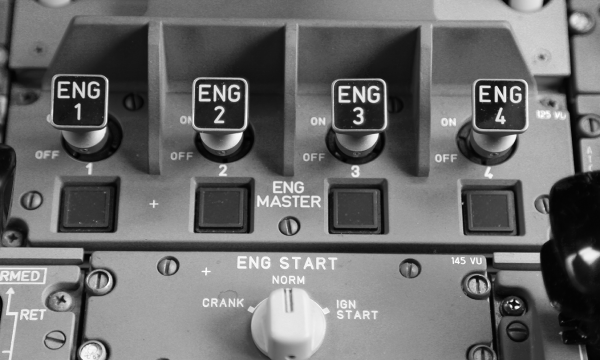Potentially hazardous, yet very successful.
Although flying involves great potential hazards and the aircraft is the most technically sophisticated means of transport, it is the safest. Based on data from 2019, the probability of an aircraft having a serious accident is one in two million. Broken down to the individual passenger, this probability is a multiple of that many times over. With 44 deaths, 2017 was the safest year in the entire history of aviation so far. The success of aviation is largely attributed to certain precaution of which we discuss the most important below
Establishment of strict procedures defining every aspect of activity
Clearly defined and well orchestrated processes consider all aspects of safety, effectiveness and efficiency. All process stakeholders can assess the actions of others and know both what to expect and what to deliver in interaction. Processes, as a superordinate unit, are again subdivided into procedures. If such procedures are applied uniformly and consistently, cover all aspects of the operations and are documented in detail, they constitute “Standard Operating Procedures” (SOP). Good SOPs are characterized by the fact that they reduce the frequency of errors within a task and increase efficiency at the same time. Nevertheless, SOPs are neither an occasion nor an obligation to give up one’s own thinking. Rather, they are intended to create mental capacity in complex environments and challenging situations by removing complex activities and interactions from the mental focus.
In aviation, the checklist has developed as an elementary tool for checking the correct and complete execution of SOPs.
Transferred to other industries and professions, the use of SOPs allows a significant improvement in the quality of work and an increase in work performance. SOPs are not only useful in mission-critical environments, such as for example operating rooms or the control centers of chemical plants or power stations, they make sense everywhere and can also lead to an improvement in work results in supposedly unimportant areas and activities.
A good source of guidelines for the development of SOPs in aviation comes from the US Federal Aviation Administration (FAA). For reading click here. This document is largely written in a way that can be understood by the general public and provides good advice that can also be used in other industries, such as medicine.
Anticipation of problems and development of solutions in advance
Another open secret of aviation safety is that all essential and probable errors have been thought through in advance, together with the appropriate measures to be taken. The aim here is to reverse the proverbial effect of “afterwards you are always smarter”. As soon as the problem is there and the affected person gets into stress, the perception ability narrows and the situational creativity decreases. Clear instructions in the form of SOPs, which include both error analysis and step-by-step handling of the error, give the person concerned confidence, reduce stress and make room for creativity. The development of abnormal and emergency procedures follows the same principles as the development of SOPs, of which they are part.
Taking just-in-time production as an example, the irregular arrival of certain parts would be classified as abnormal situation with regard to the supply chain that requires corrective action. Following the same example, the absence of a component would be considered an emergency situation requiring immediate action.
Comprehensive training
Good training is based on good documentation, a good visual presentation and a comprehensive explanation. It always appeals to several senses at the same time and keeps the students’ attention in the form of interaction, questions or tasks. However, the aim of the training is not only to explain processes and procedures but also to provide background knowledge. In the case of abnormal and emergency situations, the knowledge imparted in the training should make it possible to incorporate the individual aspects of the situation and, if necessary, circumstances that have not been taken into account or have been insufficiently considered in the SOPs. Only this additional knowledge allows the user to recognize if SOPs do not help and if and how they can best be deviated from. Repeated and extensive training in a realistically simulated environment creates self-confidence. This requires not only very expensive flight simulators. Interpersonal situations also require simulation and subsequent analysis. Analysis and feedback are also two essential elements of good training. They include the self-assessment of the candidate in order to promote the development of a realistic self-image and a positive feedback on essential points. Stress, fear and pressure are inappropriate for training.
Well-prepared training does not always require a teacher. For extensive and complex contexts, “Computer Based Training” has established in the aviation industry, which allows an audiovisual presentation and interaction of the learner. Such forms of learning can also be applied in other industries and companies far removed from aviation, for example in the field of teaching occupational safety measures, regulations on plant safety or hygiene measures.
Resource Management
The handling of resources must be learned. Both too many and too few or contradictory sources can influence the decision-making process and have a negative impact on the solution of a task or problem. Knowledge of the human psyche and physis as a reason for human-error is a part of successful resource management. In conjunction with certain tools for communicating and questioning the decisions and actions already taken, wrong decisions can be detected and corrected. The primary goals of resource management are to achieve improved situational awareness, develop self-confidence, develop leadership and assertiveness, provide models for decision making, promote flexibility and adaptability, improve event analysis, and to enable a clear and unambiguous communication.
The tools used in aviation can also be applied in other areas where irreversible and time-critical decisions are made, such as medicine.
Extensive quality management
Many companies and industries have already recognized quality management for themselves and use it to increase effectiveness, efficiency and customer satisfaction. Airlines do not impose it on themselves, for them it is prescribed by law. Since quality management within the airlines is also significantly concerned with legal compliance, it has also been called Compliance Management for several years. A good quality management is independent, communicative, critical, helpful, active and committed.
Comprehensive risk management
An airlines’ operational risks are reduced to an acceptable minimum by a Safety Management System. This involves working in three directions: reactive, proactive and predictive safety.
The principles and procedures of the Safety Management System are not reserved solely for aviation. They are now also used in the maritime and railway industries and in medicine as ISO 45001 standard for the management systems of occupational health and safety.
For more details we recommend Document 9859 of the International Civil Aviation Organization (ICAO). For reading click here. It also offers interested non-aviation readers deep insights into the safety management of airlines. Many of the concepts and strategies discussed in this paper can be applied to other industries.
Structured and comprehensive documentation
All operating procedures and regulations in an airline are written down in an Operations Manual. Contents and structure of this manual are prescribed by law. Within the European regulatory area, the Operations Manual basically consists of four parts containing general, aircraft-specific, navigational and training matters. In addition, the procedures for compliance and safety management are also written down. Depending on the scope of the operations approval, additional documentation is required. Despite the already considerable legal requirements, larger airlines voluntarily maintain corporate manuals in which procedures and work instructions for all employees or employees of areas not covered by aviation law are specified. The considerable effort pays off. The documentation is the basis and common understanding of work processes and procedures. It serves as a manual, reference work and basis for training. In addition to the documentation as such, it is also important that the documentation is up-to-date, that all recipients of the documentation are informed about changes and are obliged to comply with these changes.
A variety of process notations have developed in the various industries, which are suitable for writing down processes and procedures depending on the application. In addition to an appropriate process and procedure notation, the structuring and provision of documentation for daily use is also significant. Using the example of an anesthetist, it makes sense to develop a Quick Reference Handbook, which can basically be found in the operating room and contains checklists for normal, abnormal and emergency conditions.
Professional attitude and culture
Most people who work in airlines take pride in their profession. People demand of themselves the ability to do their job well and to constantly learn new things. This has resulted in a professional attitude and a culture of intrinsic motivation for learning and improvement.
Companies from other industries can also benefit from such a culture and can promote its development.
Together we move your business forward.
GMP has extensive experience in the definition and documentation of Standard Operating Procedures. Among our partners we have certified crew resource management trainers, certified and recognized quality and compliance managers as well as experienced training captains and certified and recognized training managers. We have experience in both operational and economic risk management. Together with you, we develop processes and procedures for your company or special application areas. Make use of our experience from the aviation industry and increase the quality of your work, become more effective and efficient and ultimately save money while increasing customer satisfaction.







